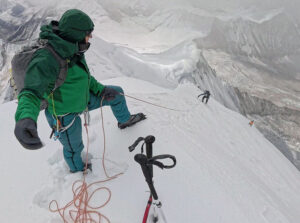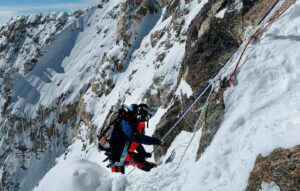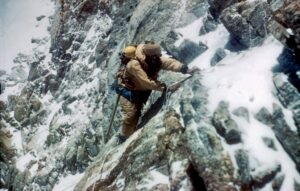Horia Colibasanu stood on the summit of Kangchenjunga at 1:15 pm on May 7, right on his self-imposed deadline for reaching the top. The final push from Camp 4 had been extremely long and, he felt, even harder than Everest.
Colibasanu, along with partners with Peter Hamor and Marius Gane, climbed without O2 or personal Sherpa support, although they paid for and used the ropes fixed up the normal route. Hamor and Gane retreated shortly after starting their own summit push.
The summit push
“Our departure from Camp 4 [on the evening of May 6] was delayed by a problem with the stove, that someone had used — and broke — while we were not there,” Colibasanu said. “We had to borrow Wilco [van Rooijen]’s. As I cooked [at the tent entrance], I saw a group coming from below, lit by their headlamps going for the summit. I couldn’t see their faces.
“Finally, we left at 11 pm. I felt the strongest of the three. I pushed a bit faster to keep warm and went ahead. It was windy, so Peter and Marius used their large, ski-like goggles, and that was their mistake. The problem is that these [particular goggles] are somehow tighter, so they slightly restrict blood flow to the face and you don’t feel the nose that much. By the time they noticed, their noses were starting to freeze.
“On the other hand, I didn’t need [these goggles]. I have a very good inner hood and could keep my regular mountain glasses. Eventually, they decided to turn around [at 8,300m] and I kept going on my own.
“I kept pushing. It was cold and sometimes windy. The wind sent spindrift right into my face. It was very, very long. Everest [from the North Side] took nine hours, from 11 pm to 8 am, but this took 14 hours. Also, the climb itself is harder, steeper and more technical.”
Colibasanu explained the longer-than-expected push. “Compared to our previous times on Kangchenjunga, the camps are pitched much lower than they used to be. This is good for O2 climbers, but for us meant a longer summit push and more time without O2 at very high altitude. Yet it is also true that we could have pitched our tent higher and we didn’t, so no complaints.”
Tough descent
“In fact, the main difference between climbing with or without O2 is during the descent. On the way up, for me, on a five to six-hour climb, I will need one extra hour [without oxygen] to reach the top. But on the way down, when you’re so tired, the difference is huge! Besides, I went down completely alone on the mountain. About one hour into the descent, I called home to say that I had summited and that I was all right and was going down. I arrived back at Camp 4 at 7:30 pm.
“The descent was hard for all three of us. O2 teams have enough energy to make it to Camp 2 or BC after the summit, but we needed two days to return. From the summit, we spent a night in Camp 4. The second day, we made it to Camp 2, utterly exhausted. Then BC on the third day.”

Left to right, Peter Hamor, Marius Gane, and Horia Colibasanu. Photo: Horia Colibasanu
Colibasanu admits the push took all his energy, and that he summited right at the deadline, in terms of safety and responsibility. Timing is essential on no-O2 climbs, as detailed in a recent story on ExWeb about the use of oxygen. Colibasanu explained that no-O2 climbers must start their summit pushes later, in order to spend less time in the bitter cold Himalayan night.
But also they need to be as fast as possible, order to reach the summit and get safely back to a camp where they can shelter he following night. Himalayan climbers agree that supplementary O2 makes a huge difference in the way cold affects the human body.
The remaining question about the Romanian-Slovak team is, What happened with their planned traverse to Yalung Khan?
“We had to give it up because Nepalese authorities wanted to charge us for an extra permit, like for another 8,000’er, even though Yalung Khan is a secondary peak,” explained Colibasanu. “We decided it was too expensive.”
Others on the mountain

Colibasanu, photographed by Mingma G, as he continues his long upward climb to the summit.
Colibasanu didn’t see Nirmal Purja, who was also on Kangchenjunga that day.
“But we saw the Princess [Asma Al Thani of Qatar]. She was with Mingma G.
“At 11 am, about two hours from the summit, I crossed paths with Mingma G and the Princess. I am sure it was them: Mingma has a distinctive blue down suit with that big “H”…apparently it is a new brand called Himal…Al Thani was also unmistakable in her down suit embroidered with Qatar’s national flag.
“Some metres behind them was a third person, clad in a basic down suit, whom I presumed was a support Sherpa. The three of them had their faces covered with O2 masks. That’s what happens on the 8,000’ers with O2 climbers — you tell one from the other by their clothes.

Mingma G in his blue down suit on the summit of Kangchenjunga, May 7. Photo: Mingma G
“They continued down and some time later, they stopped to greet Peter and Marius (who had returned to Camp 4). My partners talked with Mingma about their climb, and he told them about my whereabouts.
“One hour before reaching the summit, I crossed paths with a second group. I am not sure, but they well could be the team I saw the night before, when I was cooking. There was also another team which was always about one hour ahead of me. They were very slow because I nearly kept pace with them, and that is not the norm when you climb without O2 and the others use it.”
Elite Exped’s Mingma Tenzi reported that he and Al Thani summited at 11:00 am. Colibasanu was surprised when he heard later that Nirmal Purja summited without O2 on the same day that he was there.
“I never heard of anyone else even trying except for the three of us. A Taiwanese climber and Hungarian Csaba Varga, who had considered the option, finally decided not to. Of course, I would have loved to talk to another no-O2 climber and shared impressions.
Colibasanu’s was the last summit on May 7. While heading down, there was no one left on the mountain as far as he could see. Mingma G’s Imagine Nepal team summited very early in the morning, between 4 am and 7:23 am. At the head of that group was American Chris Warner, Chhiring Sherpa, and Pemba Sherpa, who were the first summiters of the day.

Peter Hamor and Marius Gane as they crossed paths with Mingma G. Photo: Mingma G
Chris Warner’s fast ascent
Warner, who completed the fastest ascent that day, said that he passed the Peak Promotions team on his way up. As he was heading down, he also passed both Horia and the Elite Exped group. Both were on their way up.
“Chhiring Sherpa and I left Camp 4 at 9 pm, behind the rest of our team and the Peak Promotions team. We passed everyone by 11 pm. Together with Pemba Sherpa, we reached the summit at 4:07 am. We started our descent at 4:30 am. By about 5:15 am, we passed all our group and the Peak Promotions group [both still heading up]. Mingma G was our team’s sweeper.

No summit views for Pemba Sherpa (left) and Chris Warner, who summited Kangchenjunga at 4:07 am. Photo: Chris Warner
“At approximately 6:30 am, we met Princess Asma Al Thani with Mingma Tenzi and Tenji Sherpa. They were doing remarkably well. We talked with them for about five minutes. Fifty metres lower, we came upon Nims, who was climbing without oxygen, and Lakpa Dendi. Another 50m lower, we met their photographer, Suman [Gurung], a Nepali.
“From later conversations with Mingma Tenzi, the Princess’s team took about six hours [from where we met them]…I’d guess they got there around 12-12:30 pm.






